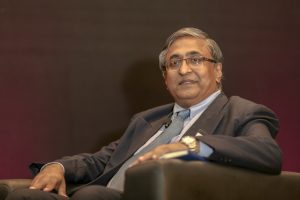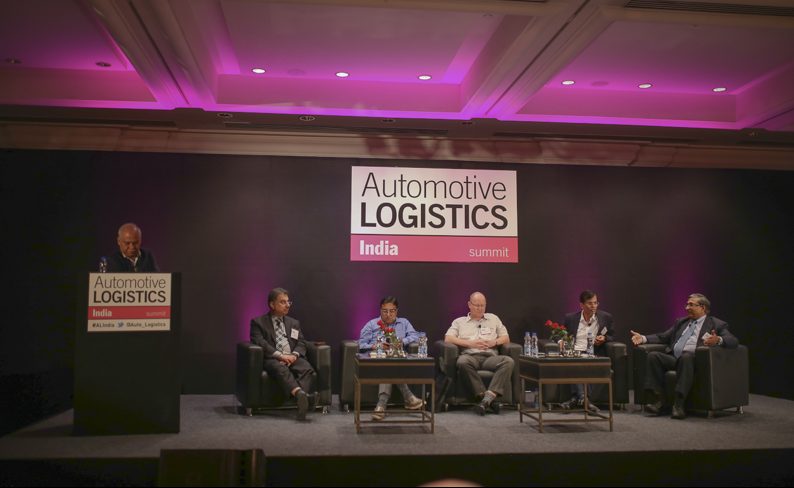Discussions at this year’s Automotive Logistics India Summit in Chennai may have sounded remarkably familiar to those who attended the very first conference a decade earlier: infrastructure deficits, underdeveloped connections, a lack of rail transport options, a fragmented logistics market, a highly bureaucratic and unproductive customs regime, and the proliferation of state border delays.
However, most delegates would also likely recognise that there has been undeniable progress, especially given the ‘once-in-a-generation’ reforms that have been implemented in the country just over the past year or two.
Significant investment in highways and other roads have improved the network; important rail reforms, especially for the automotive industry, have created more opportunities and investment, including specialised rail wagons; and, of course, there have been major legislative changes.
New dimension and safety requirements for car carriers came into force in April, with carmakers and logistics providers scrambling to make their truck fleets compliant and secure new capacity. Meanwhile, this summer saw the implementation of the long-awaited Goods and Services Tax (GST) begin, which some expect will improve multimodal logistics and distribution.

“GST was the talk of the town, now it is the walk of the town – everybody is busy adjusting their accounts and reporting systems,” said Achal Paliwal, head of Tata Motors’ outbound logistics and sales division, TML Distribution.
“We are at the right time and right place to build opportunities for newer ways of distributing finished vehicles to reach customers faster, and today there are more companies coming from outside with worldwide experience and services to offer their services,” he added.
The legislative changes have been significant, especially after the “policy paralysis” of previous years, as one delegate put it, and are regarded as essential for the country’s logistics industry to compete on a global basis.
“India wants, and needs, to catch up with the rest of the planet. I think it has the ambition to do that. I think these reforms are very positive,” commented Colin MacDonald, managing director and CEO of Renault Nissan Automotive India, responsible for the carmaker's large production plant in Chennai and operations in the country.
“Always with change, there are difficulties. It is normal and not unique to India – trust me. I would encourage India to change faster, because there is so much to catch up on. If India wants to catch up with and overtake China, if India wants to be a global supplier of all sorts of goods around the world, we need to change fast,” he added.
In his presentation at the event, Amit Bhardwaj, senior research officer (transport) at the National Institution for Transforming India (NITI Aayog), a government-sponsored think-tank, cited the World Bank Logistics Performance Index when highlighting the country’s overall improvement in recent years.
India’s ranking in the index has risen from 54th in 2014 to 34th in 2016. Among the sub-categories, infrastructure and customs have improved massively; while Bhardwaj said there was a need to further improve logistics costs and timeliness.
Seamless inter-state access is seen as key to speeding up the movement of goods in the country, according to Bhardwaj.
Probably the most significant legislative change has been the introduction of the GST as a means to simplify interstate trade, reduce tax bureaucracy and create a common market in India.
While speakers admitted that some aspects of the GST rollout have been confusing – including six different tax classes and a number of changes in the first months for some vehicle categories – executives also pointed to the benefits starting to show with improved journey times on some of the country’s major routes. A variety of OEM executives and logistics experts at the summit gave examples of how GST, which took over a decade to bring to fruition, was already showing positive signs for the logistics industry.
 Prem Verma, project leader of logistics at Tata Motors
Prem Verma, project leader of logistics at Tata Motors“This GST is one thing that we have been wanting for a very, very long time. I would say there are certain policy changes that have happened in the last two years related to the logistics industry [and] I do not know when we will see this type of reform again,” said Prem Verma, project leader logistics at Tata Motors, and who has led much of Tata's vehicle logistics for the past decade.
Strong local marketFrom a car sales perspective, the Indian automotive market has been growing faster this year than almost all major markets, including China and Asia, the US and Europe. This despite the implementation of GST, which had a negative effect on sales prior to its implementation.
Speaking at the summit, Puneet Gupta, associate director for vehicle sales forecast for South Asia at research firm IHS Markit, highlighted the country’s impressive growth in sales over the past 10 years, with 3.4m light vehicles sold in 2016 – double the number of a decade ago.
Indian light vehicle sales are expected to climb further to 3.7m this year, a gain of 9.1%, with a further 11% rise in 2018 to 4.1m and as much as 5.3m units by 2021, according to IHS data.
By 2020, the Indian market is expected to become the third biggest in the world, despite not featuring in the top 10 in 2007. Meanwhile, vehicle exports’ share of total production is set to decline in coming years as carmakers use their manufacturing capacity to meet this growing rate of local market demand, according to Gupta.
Leading global trendsOne thing that has become clear over the past decade, of course, is that although the Indian market and consumers have special characteristics, they are subject to the same global forces as other markets, and in fact India often leads the way.
The compact SUV boom has been something of an example in recent years. And for the future, the automotive industry in India is now grappling with broader changes to mobility.
Indian consumers are readier than most to shop online and access services by mobile phone. And now, with the government incentivising electric and essentially de-incentivising diesel and even hybrid cars – hybrids are heavily taxed in the new GST regime, while pure battery electric cars get a large tax break – the future of the Indian automotive industry looks set to move towards green and sustainable models.
 Vinodha Jeyanthilal, director, business strategy and planning AP SP&L at Ford
Vinodha Jeyanthilal, director, business strategy and planning AP SP&L at FordVinodha Jeyanthilal, director, business strategy and planning in Asia Pacific for service parts and logistics at Ford, said the introduction of electric vehicles might also change the economics of service parts significantly, given the large portion of cost associated with the battery.
She argued that because of this, at the time the battery needed to be replaced, consumers might consider buying a whole new vehicle rather than putting a new battery in the old one. Over time, this could shorten the average life of India’s ‘mature’ car parc, she suggested.
In addition, the next decade will very much see the connected and shared vehicle age become part of India’s automotive and supply chain landscape – something that will many implications for logistics, from the shape of the supply chain itself to the IT and delivery services that providers offer manufacturers, and of course how OEMs sell to and service their customers.
Sandeep Sharma, head of supply chain for automotive at Continental India, addressed some of the challenges that these changes in the automotive sector would have on the supply chain, estimating that electronics would make up half of the total cost of a car by 2030.
This compares to 35% in 2010 at a time when driver assist, other active and passive safety systems, infotainment and radar all start to become more prevalent. In 1990, meanwhile, just 15% of the cost of a car was electronics. This change should prompt differences in the way carmakers manage their supply chains, including in terms of speed, inventory and information. But some analysts have seen few signs of change.
“In India, I have been interacting with all of our OEM customers but somehow they still think of the electronics supply chain in the same way as a mechanical parts supply chain,” said Sharma.
He said growth in demand from the automotive market for electric goods was set to outpace all other markets, including communications, consumer and computers in coming years.
Using Indian government data from 2008-2009, Sharma said demand in the Indian market for electronics stood at $45 billion, with domestic production only catering for $20 billion of this.
He added that at the current rates of growth, domestic production could reach $100 billion against demand of $400 billion, with the rest needing to be met by imports.
“It means longer lead times and longer supply chains, so you may not get your parts in time,” said Sharma.
He said if the gap was not closed, government estimates showed electronic imports could exceed the value of oil imports into India by 2020. [mpu_ad]
Kalpesh Pathak, vice-president, purchase and supply chain management at FCA India, which recently started building the Jeep Compass at its plant in Pune for the domestic market and export, said technology had not been used enough in the supply chain and would need to be adopted further as finished vehicle production volumes grew in the country.
“Technology and integrated planning are the key areas where I think we need to focus as an industry – OEM, supplier base and service providers,” said Pathak.
Changing the transport mixMoving this ever-increasing quantity of finished vehicles around the country is likely to require an improvement in the transport mix and potential collaboration using hub and spoke methods, according to the experts.
“There is a need for integrating multimodal solutions. Our reliance on the truck is too high, and we need more trains – we need to move away from road to train. The infrastructure on the road is not good enough today already,” said Renault Nissan’s MacDonald.
“There has to be some ability to easily connect a train to the hub and then deliver the last few kilometres by truck. That is the next breakthrough for automotive logistics for me in this country,” he added.
The current modal mix for general freight transport in India is skewed towards road at nearly 60% of total volume with underutilisation of lower cost modes such as rail (31%), water and air transport, according to Bill Garrett, president and CEO of Vascor, an automotive logistics joint venture between APL Logistics and its subsidiary, Vascor.
Putting this into perspective, Garrett said the share for road transport was much lower in other major economies such as China (30%), the US (37%) and Europe (10%).
However, even these numbers are far above the ratio of automotive goods that are moved by rail in India, where very few automotive parts move by rail, and a relatively low (though growing) share of finished vehicles.
Garrett said that a single train could take 40-50 trucks off the road for the longest leg of a journey.
“I believe it is the automotive industry’s responsibility to society to do what they can to minimise the carbon footprint, and getting off the trucks and onto rail is one way to make that happen,” said Garrett.
He and S Anantharaman, chief operations manager at state-owned Southern Railway, a regional division of the state-owned Indian Railways, spoke of the efforts their respective companies were making to grow the number of finished vehicles transported by rail in the country.
APL Logistics Vascor was the first international third-party logistics provider to obtain the Automobile Freight Train Operator (AFTO) licence administered by Indian Railways, allowing it to operate its own, specialised rail wagons. The joint venture has invested 2.5 billion rupees ($36m) since entering the country in 2012 and in 2014, it started operations shipping cars via rail, with the first train leaving from Chennai to Delhi. From moving just 3,000 vehicles with two rakes – or block trains – in operation in 2014, the company now expects to move 80,000 this year across eight rakes. Next year, it plants to increase volume to 140,000 units across 15 rakes.
Anantharaman said automotive annual volumes on Southern Railway remained insignificant when compared with the likes of coal (52% of total volumes), fertilisers (13%) and cement (5%).
The number of car carrying rake journeys has, however, continued to increase in recent years, reaching 194 in the most recent financial year, compared with just 117 two years earlier, he said.
“By the middle of next year there will be 15 rakes on circuit which will practically mean that every day, there will be an auto loading and downloading point,” said Anantharaman. Indian Railways does not use specialised rail wagons, but converted passenger trains to move vehicles – assets in which Anantharaman said the company is investing in further.
Short-sea shipping has also been trialled in India in collaborations between various OEMs in the past, although this has largely been seen as unsuccessful to date, according to delegates at this year’s summit.
“It was a good exercise for us in trying to learn the pros and cons of trying to use the coastal solution here. I don’t think we have given up, but a key issue is that we need the vessel to be full in both directions,” said MacDonald.
OEMs also agreed that further collaboration between carmakers in logistics could help unlock further success in the country’s automotive industry.
 Anand Venkateswaran, senior general manager, sales logistics at Hyundai in India
Anand Venkateswaran, senior general manager, sales logistics at Hyundai in IndiaAnand Venkateswaran, senior general manager for sales logistics at Hyundai in India, the country's second largest producer and seller of vehicles, said: “I have no doubt we should share the resources in terms of yard utilisation because it will bring the cost of that asset down, because we would share the space with the other brand manufacturers and also the operating expenses would come down when you churn out a large number of units.”
He went on to say that the “cheapest warehouse would, of course, be to have no warehouse at all and to rather distribute direct from plant to dealer”, but added that taking the hawkish view of major growth in the market over the coming years, storage hubs would probably remain essential.
Following the significant change politicians have made in the country over recent years, the focus seems to have shifted now onto how industry can show the benefits in the market.
“We feel the government has done its bit. Now it is really up to us to see how we can take advantage of that and see a leapfrog [forward] in terms of logistics. We have no more excuses to give,” concluded Jasjit Sethi, CEO of TCI Supply Chain Solutions.
Automotive Logistics India is part of the global Automotive Logistics series of conferences.
The next conference in the series is the Automotive Logistics South America summit, which will be held on November 28th in São Paulo, Brazil.
Topics
- APL Vascor
- Asia
- Continental
- FCA
- features
- Fiat Chrysler Automobiles
- Finished Vehicle Logistics
- Ford
- Ford
- Hyundai
- IHS Markit
- Inbound Logistics
- India
- Inventory management
- Nissan
- NITI Aayog
- OEMs
- Policy and regulation
- Rail
- Renault-Nissan
- Road
- Service Part Logistics
- Shipping
- Southern Railway
- Stellantis
- Supply Chain Planning
- Tata
- Vascor






































